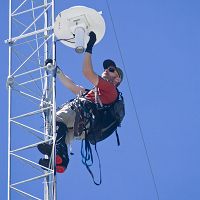Bales et al., 2011
Soil Moisture Response to Snowmelt and Rainfall in a Sierra Nevada Mixed-Conifer Forest.
Bales, R.C., Hopmans, J., O'Geen, A.T., Meadows, M., Hartsough, P.C., Kirchner, P., Hunsaker, C.T., Beaudette, D. (2011)
Vadose Zone J., 10:786-799.
-
Sierra, INVESTIGATOR
-
Sierra, COLLABORATOR
-
Sierra, INVESTIGATOR
-
Sierra, STAFF
-
Sierra, INVESTIGATOR
-
Sierra, GRAD STUDENT
-
Sierra, INVESTIGATOR
Abstract
Using data from a water-balance instrument cluster with spatially distributed sensors we determined the magnitude and within-catchment variability of components of the catchmentscale water balance, focusing on the relationship of seasonal evapotranspiration to changes in snowpack and soil moisture storage. Co-located, continuous snow depth and soil moisture measurements were deployed in a rain–snow transition catchment in the mixed-conifer forest in the Southern Sierra Nevada. At each elevation sensors were placed in the open, under the canopy, and at the drip edge on both north- and south-facing slopes. Snow sensors were placed at 27 locations, with soil moisture and temperature sensors placed at depths of 10, 30, 60, and 90 cm beneath the snow sensor. Soils are weakly developed (Inceptisols and Entisols) and formed from decomposed granite with properties that change with elevation. The soil– bedrock interface is hard in upper reaches of the basin (2000 m) where glaciers have scoured the parent material approximately 18,000 yr ago. Below an elevation of 2000 m soils have a paralithic contact (weathered saprolite) that can extend beyond a depth of 1.5 m, facilitating pathways for deep percolation. Soils are wet and not frozen in winter, and dry out in the weeks following spring snowmelt and rain. Based on data from two snowmelt seasons, it was found that soils dry out following snowmelt at relatively uniform rates, however, the timing of drying at a given site may be offset by up to 4 wk because of heterogeneity in snowmelt at different elevations and aspects. Spring and summer rainfall mainly affected sites in the open, with drying after a rain event being faster than following snowmelt. Water loss rates from soil of 0.5 to 1.0 cm d −1 during the winter and snowmelt season reflect a combination of evapotranspiration and deep drainage, as stream baseflow remains relatively low. About one-third of annual evapotranspiration comes from water storage below the 1-m depth, that is, below mapped soil. We speculate that much of the deep drainage is stored locally in the deeper regolith during periods of high precipitation, being available for tree transpiration during summer and fall months when shallow soil water storage is limiting. Total annual evapotranspiration for water year 2009 was estimated to be approximately 76 cm.
Citation
Bales, R.C., Hopmans, J., O'Geen, A.T., Meadows, M., Hartsough, P.C., Kirchner, P., Hunsaker, C.T., Beaudette, D. (2011): Soil Moisture Response to Snowmelt and Rainfall in a Sierra Nevada Mixed-Conifer Forest. Vadose Zone J., 10:786-799. . DOI: 10.2136/vzj2011.0001
 This Paper/Book acknowledges NSF CZO grant support.
This Paper/Book acknowledges NSF CZO grant support.
Explore Further







